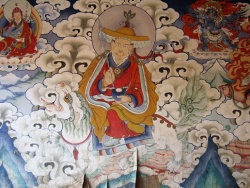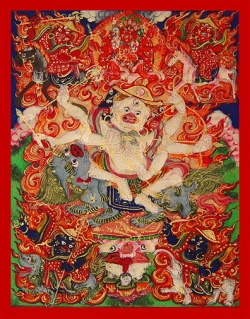Gyalpo spirits
Gyalpo spirits are one of the eight classes of haughty gods and spirits (lha srin sde brgyad) in Tibetan mythology and religion. Gyalpo (Tibetan: རྒྱལ་པོ, Wylie: rgyal po), a word which simply means "king" or "raja" in the Tibetan language, in Tibetan mythology is used to refer to the Four Guardian Kings (Tibetan: རྒྱལ་ཆེན་བཞི) and especially to a class of spirits, both Buddhist and Bön, who may be either malevolent spirits or oath-bound as protector deities (Tib. chos skyong; Skt. dharmapālas).
Nature
Geoffrey Samuel describes these Gyalpo spirits as "king-spirits" who are "the spirits of evil kings or of high lamas who have failed their vows." He also states that they are white in color. Nebesky-Wojkowitz characterizes this type of spirit as generally red in colour and of violent character, harassing mainly lamas and religious people, but also laity and even animals. In fact Gyalpo spirits often have both white (peaceful) and red (wrathful) forms.
It is believed one can be protected against Gyalpo spirits by means of appropriate rituals. In religious meditation instructions texts attributed to Padmasambhava, he warns his disciples against magical displays of this class of spirits.
Some gyalpos are believed to be bound by oath by Padmasambhava, for example Gyalpo Pehar is believed to be the main guardian of the Samye temple build at the time of Padmasambhava and the king Trisong Detsen.
Machig Labdron enumerates outer, inner and secret ways gyalpo spirits manifest. The outer way are very elegant temples with beautiful ornaments, crystal stupas and many offerings, rich with silver and gold, with well dressed monks giving teachings, full of charisma; their characteristic provocation is nervousness and confusion. Tulku Urgyen Rinpoche (1920–1996) wrote that as very often gyalpos manifest as masters, spiritual teachers and enlightened beings, several highly realised practitioners of the past fell for their tricks. Tibetans believe that when one dreams of a lama this may be a Gyalpo spirit. In Vajrayana there exist special methods for checking whether a being manifesting as one's spiritual master is really the guru or a gyalpo. There also exist special practices for protecting oneself from the influence of gyalpos or cutting off the negative influence if one has done gyalpo practice in the past.
Some lamas state that enlightened beings sometimes appear in the form of Gyalpo spirits or that such protectors may have a dual nature. Lelung Shepay Dorje writes, "Those such as the great yaksha Tsiu Marpo and King Gyalpo Pehar are, in actuality, definitely Buddhas, and fully renowned as protectors of Buddha's teachings... With one expression Pehar may help someone, and with another he may obstruct someone, but his actions are not conceivable to ordinary thought. When dispatched for activity, Pehar is made offerings in the aspect of a Dharma protector and requested to perform activities, while, on the other hand, the very same Pehar is often dispatched on missions in the aspect of a demon."
Gyalpo Pehar
According to Tibetan Buddhist myth, Gyalpo Pehar (Tibetan: རྒྱལ་པོ་དཔེ་ཧར, Wylie: rgyal po dpe har [also spelt:pe kar & dpe dkar) is the chief spirit belonging to the gyalpo class. When Padmasambhava arrived in Tibet in the eighth century, he subdued all gyalpo spirits and put them under control of Gyalpo Pehar, who promised not to harm any sentient beings and was made the chief guardian spirit of the Samye Temple built at that time. Some Tibetans believe that the protector of Samye sometimes enters the body of a medium (called the "Dharma Lord of Samye") and acts as an oracle.
Nechung Gyalpo
The Great Dharma King (rgyal chen) Nechung Dorje Drakden (rdo rje grags ldan) or Nechung Chokyong (chos skyong) is considered to be the chief minister of Gyalpo Pehar or the same as the activity aspect of Gyalpo Pehar. It is the spirit of this deity which possesses the Nechung Oracle or State Oracle of Tibet.
Source
Gyalpo Sum
In the Sakya branch of Tibetan Buddhism, the Gyalpo Sum (Tibetan: རྒྱལ་པོ་གསུམ་, Wylie: rgyal-po gsum, "three king-spirits") are three spirits which were traditionally said to protect the main Sakya Monastery. These three are Tsiu Marpo, Dorje Setrap, and Gyalpo Shugden. In view of the modern controversy about Dorje Shudgen within the Gelug school, HH Sakya Trizin the head of Sakyas issued a letter in 1996 stating that some Sakyas worshipped Shugden as a lower deity but Shugden was never a part of the Sakya institutions.
Trinley Kalsang's research demonstrates that Dorje Shugden was at one time worshipped as an emanation of Buddha by the important Sakya lama, Morchen Kunga Lhundrub (1654–1728). The oldest known ritual dedicated to Dorje Shugden was composed by the Drugpa Kagyu Lama Dreu Lhepa and Sakya Morchen Lhundrup. Bell interprets these two instances as indicating "something of Dorje Shukden's initial ecumenical appeal."
Gyalchen Shugden
Gyalchen Shugden (Tibetan: རྒྱལ་ཆེན་ཤུགས་ལྡན, Wylie: rgyal chen shugs ldan, ZYPY: Gyaiqen Xudain) The current 14th Dalai Lama has declared Dorje Shugden or Dholgyal ('gyalpo of Dhol') to be a gyalpo, and has controversially banned this practice from Tibetan monasteries. Some other lamas, especially from other schools, consider him a gyalpo. However, Trijang Rinpoche, the "root Guru" of the Dalai Lamat that just as Setrap is an emanation of Buddha Amitabha, Dorje Shugden is an emanation of Buddha Manjushri, asking "What worse karma could there be than denying this and asserting that he was reborn in the preta realm?" Thus, he criticized those who mistake Dorje Shugden's provisional appearance in the form of a gyalpo as being his definitive nature, explaining that an enlightened being appearing in the aspect of a gyalpo to benefit living beings is not the same as an enlightened being actually taking such a lower rebirth. Some other learned Gelugpa Lamas also consider Dorje Shugden to be an emanation of Buddha Manjushri and a protective deity.


